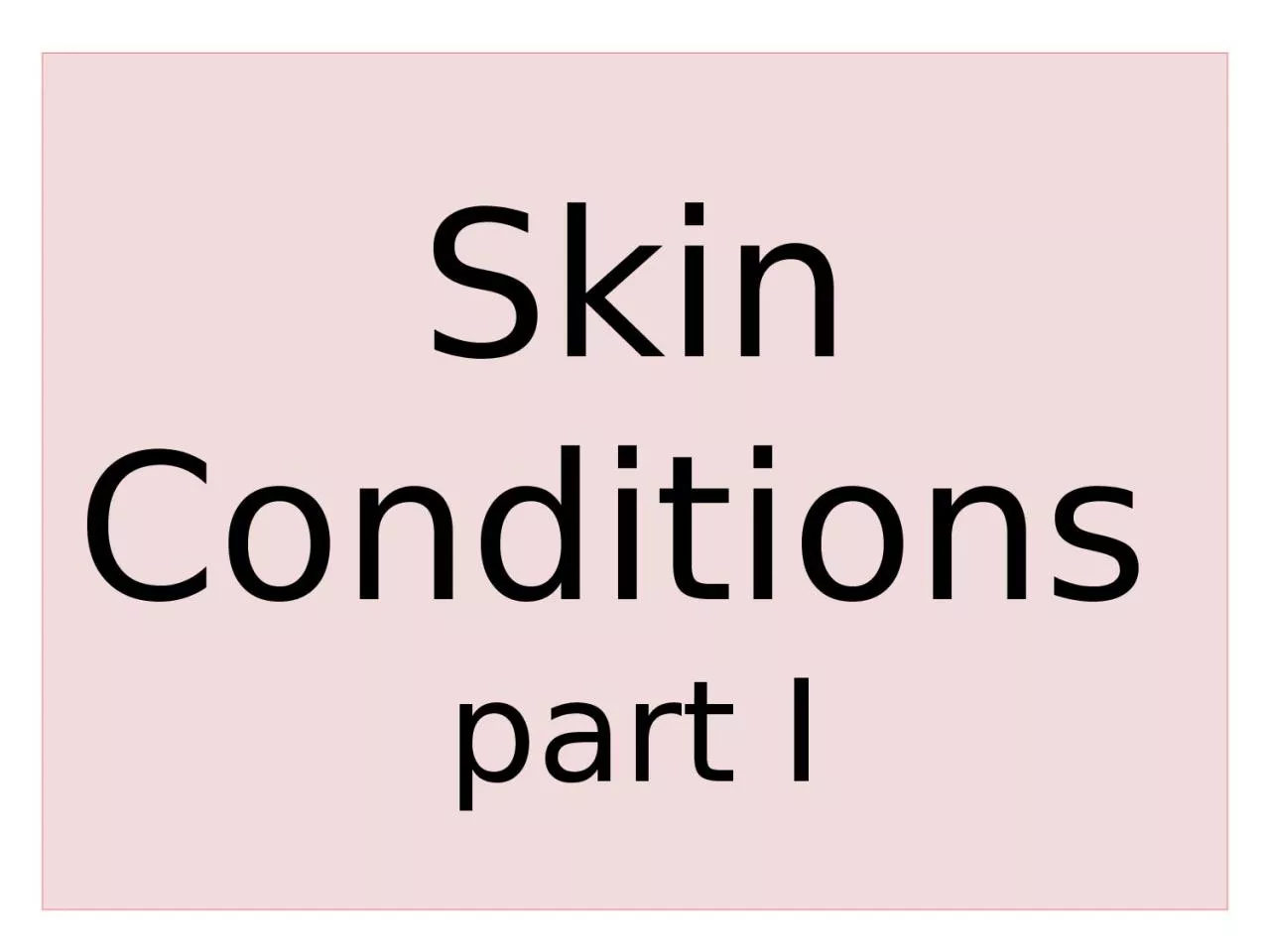

Main topics Eczema Fungal Skin Infection Acne Scabies Eczemadermatitis Skin conditions characterized by dryness erythema itch of the skin with weeping and crusting Contact dermatitis ID: 998138
Download Presentation The PPT/PDF document "Skin Conditions part I" is the property of its rightful owner. Permission is granted to download and print the materials on this web site for personal, non-commercial use only, and to display it on your personal computer provided you do not modify the materials and that you retain all copyright notices contained in the materials. By downloading content from our website, you accept the terms of this agreement.
1. Skin Conditions part I
2. Main topicsEczemaFungal Skin InfectionAcneScabies
3. Eczema/dermatitisSkin conditions characterized by dryness, erythema, itch of the skin, with weeping and crusting.Contact dermatitis (irritation or allergy). Atopic eczema (with endogenous cause ).
4. Contact dermatitis & Atopic eczema Typical eczema dermatitis rashAtopic eczema.
5.
6.
7. Patient assessmentAge/distributionItchingOccupation/contactHistory of hay fever/asthmaSeverity…
8. Aggravating Factorshay-fever season.house dust or animal danders. soaps or detergents and cold wind (dry the skin ).Certain clothing such as woollen material can irritate the skin. Cow’s milk, eggs and some food colouring.Emotional factors, stress and worry. Antiseptic solutions applied directly to the skin or added to the bathwater.
9. MedicationSensitisation to topical medicaments. Local anaesthetics, antihistamines, antibiotics and antiseptics can all provoke allergic dermatitis. Some preservatives may cause sensitisation. You need to know already used medication.
10. When to referEvidence of infection: weeping, crusting, spreadingSevere condition: badly fissured/cracked skin, bleedingFailed medication (1 week)No identifiable cause (unless previously diagnosed as eczema)No improvement after 1 week with topical corticosteroids
11. Treatment Timescale (1 week) Non-pharmacological advicesManaging the itch and avoid the irritant wearing gloves to protect the skin,Avoid drying soap.
12. Pharmacological TreatmentEmollientsTopical corticosteroids (hydrocortisone and clobetason)Antipruritics (Calamine or crotamiton)
13.
14. CS measuremant
15. Fungal Skin Infection
16. SiteName Scalp Tinea capitis Feet Tinea pedis Groin Tinea cruris Body Tinea corporis Nails Tinea unguium (onychomycosis)
17. The fungus that causes the disease thrives in warm, moist conditions.The problem is more common in men than in women and responds well to OTC treatment.
18. Patient Assessment AppearanceSeverityLocationPrevious historyMedication
19. When to ReferSevere, affecting other parts of the footSigns of bacterial infectionUnresponsive to appropriate treatmentDiabetic patientsInvolvement of toenails
20. Affecting other parts of the foot
21. Affecting other parts of the foot
22. Severe case
23. Involvement of toenails
24. Signs of bacterial infection
25. Management2 weeksPharmacists should instruct patients on how to use the treatment correctly to prevent recurrence. Clean and dry your feet. treatment must be continued for 1–2 weeks after the disappearance of all signs of infection to ensure eradication of the fungus
26. Azoles (Miconazole, clotrimazole, ketconazole) TerbinafineGriseofulvin TolnaftateUndecenoates (e.g. zinc undecenoate)Hydrocortisone Topical Anti-fungal Choose the Right dosage form
27.
28. AcneAcne vulgaris is a common condition in young people. It is not usually serious and resolves in most patients by the age of 25. Peak incidence of acne is 14–17 years in females and 16–19 years in males. The condition normally resolves in the majority of patients within 10 years of onset.
29.
30. EtiologyThe hormonal changes especially the production of androgens. Increased keratin and sebum production during adolescence leads to blockages of the follicles and the formation of microcomedones. A microcomedone can develop into a non-inflammatory lesion (comedone), which may be open (blackhead) or closed (whitehead), or into an inflammatory lesion (papule, pustule or nodule). Excess sebum encourages the growth of bacteria, particularly Propionibacterium acnes, which are involved in the development of inflammatory lesions.
31. Patient AssessmentAgeSeverity…Affected areas … Medication
32. SeverityMild acne: predominately open and closed comedones with few inflammatory (papulopustular) lesions mainly the face. Moderate acne: A patient with moderate acne has many inflammatory lesions that are not confined to the face. painful and there is a possibility of mild scaring.Severe acne: the characteristics of moderate acne plus the development of cysts. Lesions are often widespread involving the upper back and chest. Scarring will usually result.
33.
34.
35. Acne or rosacea
36. When to referModerate and Severe acneFailed medicationSuspected drug-induced acne
37. Management of mild acne Time scale 8 weeksBenzoyl peroxide (2.5%, 5%, and 10% gels, lotion, cream)AntibacterialsTopical Retinoids (Adapalene/ Differin Gel 0.1%)
38. Practical pointsDietContinuous treatmentSkin hygieneTopical hydrocortisone and acne
39. Treatment timescaleimproved within 8 weeksOnly mild acne can be managed by the pharmacist using OTC products, moderate and severe acne should be referred.
40.
41. Scabiespruritic skin conditiondirect physical contactLong Incubation period
42. Scabies life span
43. Patient Assessment Age Symptoms Signs of infectionFamily Medical history Medication History
44.
45. When to referBabies and children under 2 yearsInfected skinTreatment failureUnclear diagnosis
46. ManagementPermethrin 5% cream, >2yrMalathion, >6MBenzyl benzoate (25% in an emulsion basis)Crotamiton (Eurax®)
47.